
- Home
- Travel Packages
- Top Destination
-
Travel Attraction
By Category
Top Attraction

- Travel Agents
- Car Rentals
- Hotels
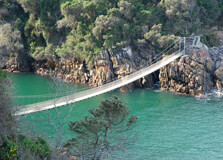
The Garden Route National Park is a picturesque paradise located on the southern coast of South Africa. It is a combination of three distinct sections – the Tsitsikamma, Wilderness, and Knysna national parks. The park covers a vast area of lush forests, pristine beaches, and dramatic coastlines, making it a popular destination for nature lovers and outdoor enthusiasts. Location and Geographical Overview The Garden Route National Park stretches along the Garden Route, a scenic stretch of coastline that runs from Mossel Bay in the west to Storms River in the east. The park is situated in the Western Cape province of South Africa, approximately a 5-hour drive from Cape Town. Opening and Closing Time The Garden Route National Park is open to visitors all year round. The gates typically open at 7 am and close at 6 pm. Entry Fee Entry fees to the Garden Route National Park vary depending on the section you are visiting and the activities you plan to do. The fees range from R40 to R200 for adults, with discounted rates for children and senior citizens. Species-Flora/Fauna Availability The Garden Route National Park is home to a diverse range of plant and animal species. The park is famous for its ancient forests, including giant yellowwoods and Outeniqua yellowwoods. Wildlife enthusiasts can also spot a variety of animals, such as elephants, buffaloes, leopards, and various bird species. Activities Performed Visitors to the Garden Route National Park can enjoy a wide range of activities, including hiking, birdwatching, picnicking, swimming, and camping. The park also offers guided walks, boat cruises, and jeep safaris for a more immersive experience. Jeep Safari Charges Jeep safari charges in the Garden Route National Park vary depending on the duration and route of the safari. Prices typically range from R500 to R1500 per person. Age Criterion and Entry Fee Entry fees for the Garden Route National Park are based on age categories. Children under the age of 12 usually enjoy discounted rates, while senior citizens may also be eligible for reduced fees. Adult entry fees apply to individuals over the age of 18. Senior Citizen Facilities The Garden Route National Park offers facilities and services tailored to the needs of senior citizens, including wheelchair-accessible paths, rest areas, and discounted rates for entry fees and activities. Best Time to Visit The best time to visit the Garden Route National Park is during the spring and autumn months (September to November and March to May), when the weather is mild, and the landscapes are lush and vibrant. However, the park is open year-round and offers unique experiences in every season. Nearby Places to Visit While exploring the Garden Route National Park, visitors can also visit nearby attractions such as the Tsitsikamma National Park, Wilderness National Park, and Knysna Lagoon. The charming towns of Knysna, Plettenberg Bay, and George are also worth a visit. Vehicle Parking Facility The Garden Route National Park provides parking facilities at designated areas near the entrance gates and popular attractions. Visitors are advised to follow the park's regulations and guidelines when parking their vehicles. Rules and Regulations Visitors to the Garden Route National Park are required to abide by certain rules and regulations to ensure the safety of themselves, other visitors, and the park's ecosystem. Some common regulations include staying on designated trails, refraining from littering, and respecting wildlife habitats. How to Reach and Other Related Information The Garden Route National Park is easily accessible by car from major cities in South Africa. Visitors can also reach the park by bus or organized tours. For more information on directions, accommodations, and activities, visitors can contact the park's visitor center or visit the official website.
Explore More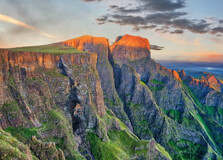
Ukhahlamba Drakensberg Park, located in KwaZulu-Natal, South Africa, is a UNESCO World Heritage Site known for its breathtaking natural beauty and immense cultural significance. Covering over 240,000 hectares, the park is part of the majestic Drakensberg Mountain Range, the highest in Southern Africa. It is renowned for its dramatic peaks, rich biodiversity, crystal-clear streams, waterfalls, and the largest collection of rock art in Africa, created by the San people over a period of 4,000 years. How to Reach Ukhahlamba Drakensberg Park, KwaZulu-Natal The park is accessible by road from major cities in KwaZulu-Natal and the surrounding provinces: By Car from Durban: The park is approximately 250 km (3-4 hours' drive) northwest of Durban. Take the N3 highway towards Pietermaritzburg and follow signs toward towns like Winterton, Underberg, or Bergville, depending on which section of the park you're visiting. By Car from Johannesburg: It's about 400-500 km (5-6 hours) south of Johannesburg, depending on the entry point. By Air: The nearest major airport is King Shaka International Airport in Durban. From there, you can rent a car to drive to the park. By Bus/Tour: Several tour operators offer group trips or private tours to the park with accommodation and activities included. Weather at Ukhahlamba Drakensberg Park The park has a temperate mountain climate: Summer (November to March): Warm and rainy with daytime temperatures between 20°C and 30°C. Thunderstorms are common in the afternoons. Winter (May to August): Cold and dry, with daytime highs around 15°C and freezing temperatures at night. Snow may fall on higher peaks. The best time to visit is during the dry months from May to September for hiking and rock art viewing. Spring (September to October) offers blooming wildflowers and moderate weather. Timings to Visit The park is open year-round. Most access gates are open daily from 6:00 AM to 6:00 PM. Specific opening hours may vary slightly by region (e.g., Royal Natal, Cathedral Peak, Giant's Castle). It is advisable to arrive early in the day for hikes and outdoor activities, especially in summer when afternoon storms can develop quickly. Why Famous for Ukhahlamba Drakensberg Park, KwaZulu-Natal? The park is famous for: San Rock Art: Home to over 600 rock art sites and 35,000 individual paintings, making it the largest and most concentrated group of rock paintings in Africa south of the Sahara. Spectacular Scenery: Towering basalt cliffs, lush valleys, waterfalls, and rolling foothills create an awe-inspiring natural landscape. World Heritage Status: Recognized by UNESCO for both natural and cultural value. Biodiversity: A hotspot for endemic species of plants, birds, and mammals. Entry and Visit Details Entry fees vary depending on the section of the park: Adults: Approx. R65 – R90 per person Children: Approx. R35 – R50 per child The park is divided into multiple areas with separate entrances, including Giant’s Castle, Royal Natal, Cathedral Peak, and Kamberg. Each has its own visitor centre, hiking trails, and facilities. Camping sites, chalets, and lodges are available for overnight stays, often with advance booking required. History and Architecture Ukhahlamba means "Barrier of Spears" in Zulu, reflecting the rugged and imposing nature of the mountain range. The San people inhabited the area for thousands of years, leaving behind a priceless legacy of rock paintings that depict daily life, animals, and spiritual beliefs. Though the park does not have classical architectural structures, it is rich in ancient cultural expressions carved and painted onto the rock faces of caves and overhangs. Rangers and cultural guides help interpret this heritage during guided tours. Things to Do at Ukhahlamba Drakensberg Park Hiking: Trails range from easy walks to challenging multi-day treks. Popular routes include the Amphitheatre hike in Royal Natal and the climb to the Tugela Falls. Rock Art Tours: Visit San rock painting sites with expert guides, particularly at Kamberg and Giant’s Castle. Bird Watching: Spot the endangered bearded vulture and many endemic species. Horse Riding: Several lodges offer horseback trails through the foothills. Photography: The park is a photographer’s paradise with dramatic landscapes, sunrises, and wildlife. Camping and Star Gazing: Camp under clear skies and enjoy one of the best natural observatories in the region. Facts about Ukhahlamba Drakensberg Park The park spans over 240,000 hectares and links to the Maloti Mountains in Lesotho, forming the transfrontier Maloti-Drakensberg Park. Tugela Falls, one of the tallest waterfalls in the world (948 meters), is located in the Royal Natal section. The San rock art dates back thousands of years and is well preserved due to the dry mountain climate. Home to more than 2,500 plant species, including many endemic to the region. Declared a World Heritage Site in 2000 for its natural beauty and cultural significance. Tips about Ukhahlamba Drakensberg Park, KwaZulu-Natal Wear layered clothing as temperatures can vary greatly throughout the day. Always carry water, sunscreen, a map, and weatherproof gear when hiking. Book guided rock art tours for in-depth understanding of San culture. Some trails and campsites require permits—check in advance. Travel in groups or inform someone of your hiking route and return time. Cell phone signal may be limited in some remote areas—carry a GPS or compass. Respect wildlife and do not disturb or damage any rock art or natural features.
Explore More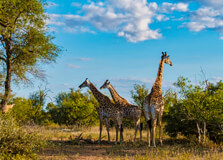
Kruger National Park, located in the Limpopo province of South Africa, is one of the largest game reserves in Africa. Covering an area of nearly 20,000 square kilometers, the park is home to a wide variety of wildlife, including the famous Big Five - lions, leopards, elephants, rhinos, and buffaloes. The park was established in 1926 and named after Paul Kruger, a former president of the South African Republic. Location and Geographical Overview Kruger National Park is situated in northeastern South Africa, bordering Zimbabwe and Mozambique. The park encompasses diverse landscapes, including open savannah, dense forests, and rolling hills. The Crocodile River runs along the southern boundary of the park, providing water for the wildlife that inhabits it. Open and Closing Time The park is open to visitors from sunrise to sunset, with specific entrance gates having varying opening and closing times. It is important to check the official website for the most up-to-date information on operating hours. Entry Fee There is an entrance fee for visitors to Kruger National Park, with rates varying for South African residents, SADC (Southern African Development Community) nationals, and international tourists. It is recommended to purchase entry permits in advance to avoid delays at the gates. Species-Flora/Fauna Availability Kruger National Park is renowned for its rich biodiversity, with over 500 bird species, 147 mammal species, and countless plant varieties. Visitors have the opportunity to spot a wide array of wildlife, from rare birds to large predators, making it a paradise for nature lovers and wildlife enthusiasts. Activities Performed There are numerous activities to enjoy within the park, including game drives, guided walks, birdwatching, and wilderness trails. Visitors can also visit cultural heritage sites and attend educational programs to learn more about the park's conservation efforts. Jeep Safari Charges Jeep safaris are a popular way to explore Kruger National Park, allowing visitors to get up close to wildlife in their natural habitat. The park offers guided safari tours, with prices varying depending on the duration and type of safari chosen. Age Criterion and Entry Fee Entry fees for Kruger National Park are typically based on age and nationality. Children under a certain age may enter for free, while discounted rates are often available for senior citizens. It is advisable to check the official website for the most current pricing information. Senior Citizen Facilities Kruger National Park offers facilities and services tailored to the needs of senior citizens, including accessible accommodation, transportation, and guided tours. Special discounts may also be available for older visitors, making it easier for them to enjoy their visit to the park. Best Time to Visit The best time to visit Kruger National Park is during the dry season, from May to September, when vegetation is sparse, and wildlife congregates around water sources. This period offers optimal game viewing opportunities and comfortable weather conditions for outdoor activities. Nearby Places to Visit There are several nearby attractions to explore while visiting Kruger National Park, including Blyde River Canyon, Bourke's Luck Potholes, and the Panorama Route. These natural wonders offer stunning views and unique geological formations that are worth seeing during your trip. Vehicle Parking Facility Kruger National Park provides designated parking areas at its entrance gates, rest camps, and popular attractions within the park. Visitors are advised to lock their vehicles and refrain from leaving any valuable items inside to prevent theft or damage. Rules and Regulations Visitors to Kruger National Park are required to adhere to strict rules and regulations to ensure the safety of wildlife and maintain the park's pristine environment. This includes staying on designated roads, refraining from feeding animals, and respecting the natural habitat of the wildlife. How to Reach and Other Related Information Kruger National Park can be accessed by road, air, or organized tours from major cities in South Africa. The closest airports are in Nelspruit and Hoedspruit, with options for shuttle services to the park. It is recommended to plan your visit in advance and book accommodations within the park or nearby lodges for a seamless experience. With its diverse landscapes, abundant wildlife, and conservation efforts, Kruger National Park offers a memorable safari experience for visitors of all ages. Whether you are a nature enthusiast, adventure seeker, or simply looking to immerse yourself in the beauty of the African bush, a trip to this iconic park is sure to leave you in awe of the natural world.
Explore More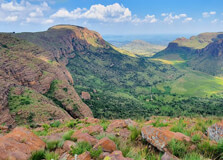
Located in Limpopo, South Africa, Marakele National Park is a breathtaking natural sanctuary that offers visitors the chance to experience the beauty of the African wilderness up close. The name "Marakele" means 'a place of sanctuary' in Tswana, and this park truly lives up to its name, providing a safe haven for a wide variety of wildlife. Location and Geographical Overview Marakele National Park covers an area of approximately 67,000 hectares and is situated in the Waterberg region of Limpopo. The park is characterized by dramatic landscapes, including towering mountains, lush valleys, and winding rivers. The diverse terrain creates a variety of habitats that support a rich array of plant and animal species. Open and Closing Time The park is open to visitors from 6:00 am to 6:00 pm daily. Entry Fee The entry fee for Marakele National Park is R100 for adults and R50 for children under 12 years old. South African citizens and residents enjoy a discounted rate of R40 for adults and R20 for children. Species-Flora/Fauna Availability Marakele National Park is home to a diverse range of flora and fauna. Visitors can expect to see iconic African wildlife such as elephants, lions, rhinos, and giraffes, as well as a variety of bird species. The park also boasts a number of unique plant species, including the rare cycads that dot the landscape. Activities Performed Visitors to Marakele National Park can enjoy a range of activities, including guided game drives, hiking trails, and birdwatching. The park also offers camping facilities for those who wish to spend the night in the wilderness. Jeep Safari Charges Jeep safari charges vary depending on the duration of the safari and the number of participants. Prices typically range from R300 to R1000 per person. Age Criterion for Male, Female, Children and their Entry Fee Adult entry fees apply to individuals aged 12 and above. Children under 12 years old receive a discounted rate. There is no specific age criterion for male or female visitors. Senior Citizen Facilities Senior citizens may be eligible for discounted entry fees, depending on their age and residency status. The park also offers facilities such as wheelchair access and designated rest areas for elderly visitors. Best Time to Visit The best time to visit Marakele National Park is during the dry season, from May to September, when wildlife congregates around water sources, making for excellent game viewing opportunities. Nearby Places to Visit Visitors to Marakele National Park can explore the surrounding area and visit attractions such as the picturesque town of Thabazimbi, the Marakele Predator Centre, and the Waterberg Biosphere Reserve. Vehicle Parking Facility The park offers designated parking areas for visitors, with ample space for both cars and buses. Overnight guests can park their vehicles at the designated camping sites. Rules and Regulations Visitors to Marakele National Park are required to adhere to a set of rules and regulations to ensure the safety of both wildlife and fellow visitors. Some of the key rules include staying on designated roads and trails, refraining from feeding or approaching wildlife, and properly disposing of waste. How to Reach and Other Related Information Marakele National Park is easily accessible by road from major cities such as Johannesburg and Pretoria. The park is located approximately 250 km from Johannesburg and can be reached via the N1 highway. Visitors can also fly into nearby airports such as Tambo International Airport in Johannesburg and arrange for transportation to the park. For more information on visiting Marakele National Park, including accommodation options, guided tours, and special events, visitors are encouraged to contact the park's visitor center or visit the official park website.
Explore More
Mapungubwe National Park is a UNESCO World Heritage Site located in the Limpopo Province of South Africa. The park is known for its rich biodiversity, cultural heritage, and stunning landscapes. It covers an area of 28,000 hectares and is home to a wide variety of wildlife, including elephants, lions, leopards, and more. Location and Geographical Overview The park is situated at the confluence of the Limpopo and Shashe Rivers, near the border with Botswana and Zimbabwe. It is characterized by sandstone cliffs, mopane woodlands, and rocky outcrops. The park's diverse habitats support a wide range of plant and animal species. Opening and Closing Time The park is open daily from 6:00 am to 6:00 pm, with the last entry at 4:00 pm. The park may have seasonal variations in opening hours, so it is advisable to check the official website before planning your visit. Entry Fee The entry fee for Mapungubwe National Park is R50 for South African residents and R100 for international visitors. Children under the age of 12 enter for free. Species-Flora/Fauna Availability The park is home to a diverse range of wildlife, including elephants, giraffes, zebras, and various antelope species. Birdwatchers will also be delighted by the park's resident bird species, which include kingfishers, eagles, and hornbills. The park is also known for its unique baobab trees and other indigenous flora. Activities Performed Visitors to Mapungubwe National Park can enjoy a variety of activities, including game drives, guided walks, and birdwatching. There are also picnic sites and viewpoints where visitors can relax and take in the park's breathtaking scenery. Jeep Safari Charges Jeep safari charges vary depending on the duration and type of safari. Prices typically range from R300 to R1000 per person, with discounts available for groups and children. Age Criterion for Male, Female, Children and Their Entry Fee The entry fee for male and female visitors is the same, with children under 12 entering for free. Children between the ages of 12 and 18 pay a reduced fee of R25. Senior citizens over the age of 60 also receive a discount on their entry fee. Senior Citizen Facilities Mapungubwe National Park offers special facilities for senior citizens, including designated parking areas, wheelchair access, and discounted entry fees. Visitors are encouraged to inquire at the park's entrance gate for assistance and information on available facilities. Best Time to Visit The best time to visit Mapungubwe National Park is during the dry season, which runs from May to September. During this time, the weather is cooler, and wildlife is more easily spotted near water sources. The park is also less crowded, allowing for a more peaceful and enjoyable experience. Nearby Places to Visit There are several attractions near Mapungubwe National Park that visitors can explore, including the Mapungubwe Cultural Landscape, the Great Zimbabwe Ruins, and the Tuli Block Game Reserve. These sites offer additional opportunities to learn about the history and culture of the region. Vehicle Parking Facility The park has designated parking areas for visitors, including secure parking for vehicles and trailers. Parking is included in the entry fee, and attendants are available to assist visitors with parking and directions. Rules and Regulations Visitors to Mapungubwe National Park are expected to adhere to the park's rules and regulations, which include respecting wildlife and natural habitats, refraining from littering, and following designated trails and roads. Camping and fires are only permitted in designated areas, and feeding or approaching wildlife is strictly prohibited. How to Reach and Other Related Information Mapungubwe National Park is easily accessible by road from major cities like Johannesburg and Pretoria. The park is approximately a 5-hour drive from Johannesburg and offers well-maintained roads for visitors. Accommodation options are available both inside the park and in nearby towns, making it convenient for visitors to plan their stay. For more information on how to reach the park and other related details, visitors can visit the official website or contact the park's administration for assistance.
Explore More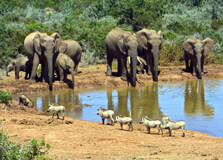
About Addo Elephant National Park Addo Elephant National Park is a renowned wildlife reserve located near Port Elizabeth in the Eastern Cape province of South Africa. The park was established in 1931 to protect the last remaining 11 African elephants in the area. Today, it is home to over 600 elephants as well as other wildlife species. Location and Geographical Overview The Addo Elephant National Park spans across an area of approximately 1,640 square kilometers and is situated about 72 kilometers north of Port Elizabeth. The park encompasses a variety of landscapes including dense forests, rolling hills, and open savannah, providing a diverse habitat for its wildlife inhabitants. Opening and Closing Time The park is open daily from 7:00 am to 6:30 pm. Entry Fee The entry fee for international visitors is R328 per adult and R164 per child. South African citizens pay R76 per adult and R38 per child. Species - Flora/Fauna Availability Aside from elephants, Addo Elephant National Park is home to a wide array of wildlife including lion, buffalo, rhinoceros, leopard, and various antelope species. The park also boasts diverse flora such as spekboom, euphorbias, and a variety of indigenous trees and shrubs. Activities Performed Visitors to the park can enjoy activities such as guided game drives, self-drive safaris, bird watching, hiking trails, and horseback safaris. The park also offers accommodation options for overnight stays. Jeep Safari Charges Jeep safari charges vary depending on the type of safari experience chosen. Prices typically range from R600 to R1200 per person for a guided safari. Age Criterion and Entry Fee Children under the age of 2 enter the park for free. The entry fee for children aged 2-11 is R82 for international visitors and R41 for South African citizens. For visitors aged 12 and above, the adult entry fee applies. Senior Citizen Facilities Senior citizens are eligible for discounted entry fees. South African citizens over the age of 60 can enjoy reduced rates upon presentation of a valid ID. Best Time to Visit The best time to visit Addo Elephant National Park is during the dry winter months from May to September when wildlife congregates around waterholes, making for excellent game viewing opportunities. Nearby Places to Visit Some nearby attractions to Addo Elephant National Park include the Zuurberg Mountain Village, the Daniell Cheetah Project, and the town of Kirkwood known for its citrus orchards. Vehicle Parking Facility The park offers designated parking areas for visitors at various points within the park. Parking is free of charge. Rules and Regulations Visitors are required to follow certain rules and regulations while inside the park such as maintaining a safe distance from wildlife, refraining from feeding the animals, and adhering to speed limits on the roads. How to Reach and Other Related Information Addo Elephant National Park is accessible by car from Port Elizabeth via the N2 highway. The park is approximately a one-hour drive from Port Elizabeth. Alternatively, guided tours and shuttle services are available for visitors without their own transportation.
Explore More
About Freedom Park Freedom Park is a significant heritage site located in Pretoria, South Africa. It was established with the aim of honoring those who sacrificed their lives for the freedom of the nation and celebrating South Africa's diverse cultural heritage. The park serves as a symbol of unity and reconciliation in the country. Location and Geographical Overview Freedom Park is situated on Salvokop Hill in Pretoria, offering panoramic views of the city and surrounding landscapes. The park covers an area of 52 hectares and features various monuments, gardens, and sculptures that represent the country's history and cultural diversity. Open and Closing Time Freedom Park is open to visitors from 8:00 am to 4:30 pm daily. It is advisable to arrive early to make the most of your visit and explore the park at your leisure. Entry Fee There is no entry fee to access Freedom Park, making it an affordable destination for both locals and tourists to experience the rich heritage and natural beauty of South Africa. Species-Flora/Fauna Availability Freedom Park is home to a variety of indigenous plant species, creating a tranquil and scenic environment for visitors to enjoy. The park also supports diverse wildlife, including birds, insects, and small mammals that thrive in the natural surroundings. Activities Performed Visitors to Freedom Park can engage in a range of activities, such as guided tours, nature walks, picnics, and cultural events. The park offers educational programs and interactive exhibits that provide insight into the country's history and heritage. Jeep Safari Charges Freedom Park does not offer jeep safari experiences. However, visitors can explore the park on foot and discover its various attractions at their own pace. Age Criterion and Entry Fee There are no specific age restrictions for entry to Freedom Park. Children under a certain age may be admitted free of charge, while adults may be required to pay a nominal fee to access certain areas or exhibits within the park. Senior Citizen Facilities Freedom Park is accessible to senior citizens and offers facilities such as benches, shaded areas, and wheelchair access to ensure a comfortable and enjoyable visit for older visitors. Best Time to Visit The best time to visit Freedom Park is during the spring months of September to November when the weather is mild, and the gardens are in full bloom. Avoid visiting during the hot summer months, as temperatures can be uncomfortably high. Nearby Places to Visit While in Pretoria, visitors can explore other attractions such as the Voortrekker Monument, Union Buildings, and National Zoological Gardens. These sites are located in close proximity to Freedom Park and offer additional opportunities for sightseeing and cultural experiences. Vehicle Parking Facility Freedom Park provides parking facilities for visitors, ensuring convenient access to the park. There may be a nominal fee for parking, depending on the duration of your visit. Rules and Regulations Visitors to Freedom Park are expected to respect the site's heritage and cultural significance by following these rules: - No littering or vandalism - No feeding of wildlife - No loud music or disruptive behavior - No unauthorized access to restricted areas - No smoking in designated non-smoking zones How to Reach and Other Related Information Freedom Park is easily accessible by car, taxi, or public transportation from Pretoria city center. The park is located approximately 5 kilometers from the central business district and can be reached via major roads such as Nelson Mandela Drive and Struben Street. Visitors can also arrange guided tours or transportation services through local tour operators for a hassle-free visit to the park. Overall, Freedom Park offers a unique and immersive experience for visitors seeking to learn about South Africa's history, culture, and natural environment. With its stunning views, educational exhibits, and peaceful surroundings, the park is a must-visit destination for anyone interested in exploring the rich heritage of the country.
Explore More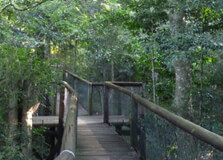
The Dlinza Forest Nature Reserve is a stunning natural treasure located in Eshowe, Kwazulu Natal, South Africa. This lush forest reserve spans over 250 hectares and is home to a diverse range of flora and fauna species, making it a popular destination for nature lovers and outdoor enthusiasts. Location and Geographical Overview The Dlinza Forest Nature Reserve is situated in the town of Eshowe, which is known as the oldest town in Zululand. The reserve is easily accessible and is approximately a 2-hour drive from Durban, making it a convenient day trip or weekend getaway destination. Open and Closing Time The Dlinza Forest Nature Reserve is open to visitors from 8:00 am to 4:30 pm every day of the week, including weekends and public holidays. Visitors are advised to arrive early to make the most of their time exploring the reserve. Entry Fee There is a nominal entry fee to access the Dlinza Forest Nature Reserve, with discounts available for children, students, and senior citizens. The entry fee helps to support the conservation efforts and maintenance of the reserve. Species-Flora/Fauna Availability The Dlinza Forest Nature Reserve is home to a wide variety of plant and animal species, including indigenous trees, birds, butterflies, and small mammals. Visitors can expect to spot unique flora and fauna as they explore the walking trails within the reserve. Activities Performed Visitors to the Dlinza Forest Nature Reserve can enjoy a range of activities, including hiking, birdwatching, picnicking, and nature photography. The reserve offers a serene and peaceful environment for visitors to connect with nature and unwind from the hustle and bustle of city life. Jeep Safari Charges The Dlinza Forest Nature Reserve does not offer jeep safari tours, as the reserve is best explored on foot. Visitors are encouraged to take their time walking through the forest trails to fully immerse themselves in the natural beauty of the surroundings. Age Criterion and Entry Fee Children under the age of 6 are admitted free of charge to the Dlinza Forest Nature Reserve. There are discounted entry fees for students, with identification required. Senior citizens aged 60 and above also receive a discount on the entry fee. Senior Citizen Facilities The Dlinza Forest Nature Reserve is equipped with facilities to cater to the needs of senior citizens, including accessible walking trails, seating areas, and restroom facilities. The reserve staff are friendly and happy to assist senior visitors during their visit. Best Time to Visit The best time to visit the Dlinza Forest Nature Reserve is during the cooler months of the year, from April to September, when the weather is mild and perfect for outdoor activities. Early mornings and late afternoons are ideal times to spot wildlife and birds in the reserve. Nearby Places to Visit While in Eshowe, visitors can explore other nearby attractions such as the Zululand Historical Museum, Fort Nongqayi, and the beautiful Dlinza Forest Aerial Boardwalk. These attractions offer a glimpse into the rich history and culture of the region. Vehicle Parking Facility The Dlinza Forest Nature Reserve provides ample parking facilities for visitors, with designated parking areas located near the entrance of the reserve. Visitors are reminded to lock their vehicles and not leave any valuables in sight to prevent theft. Rules and Regulations Visitors to the Dlinza Forest Nature Reserve are reminded to respect the natural environment and wildlife during their visit. Littering, feeding wildlife, and making loud noises are strictly prohibited. Pets are not allowed in the reserve to protect the flora and fauna. How to Reach and Other Related Information The Dlinza Forest Nature Reserve is easily accessible by car from Durban, with well-maintained roads leading to Eshowe. Visitors can also opt for public transportation or organized tours to reach the reserve. For more information on visiting the reserve, including guided tours and educational programs, visitors can contact the reserve office directly.
Explore More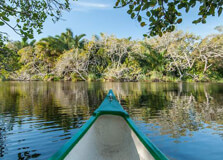
Greater St Lucia Wetlands Park
The Greater St Lucia Wetlands Park, located in the province of KwaZulu-Natal in South Africa, is a UNESCO World Heritage Site known for its diverse ecosystems and wildlife. The park spans over 280 km of coastline along the Indian Ocean and includes a variety of habitats such as beaches, coral reefs, wetlands, and savannas. Location and Geographical Overview The Greater St Lucia Wetlands Park is situated in the northeastern part of KwaZulu-Natal, near the town of St Lucia. It is bordered by Lake St Lucia to the west and the Indian Ocean to the east. The park is easily accessible by road and is approximately a 2-hour drive from the city of Durban. Open and Closing Time The park is open to visitors from 6:00 AM to 6:00 PM daily, allowing ample time to explore the diverse landscapes and wildlife that the park has to offer. Entry Fee There is an entry fee for visitors to the Greater St Lucia Wetlands Park, with different rates for South African residents and international tourists. South African residents can expect to pay a lower fee compared to international visitors. The entry fee includes access to the various sections of the park and guided tours, if desired. Species-Flora/Fauna Availability The park is home to a wide range of plant and animal species, making it a biodiversity hotspot in South Africa. Visitors to the Greater St Lucia Wetlands Park can expect to see a variety of wildlife, including hippos, crocodiles, various bird species, and even the occasional leopard. Activities Performed Visitors to the park can partake in a variety of activities, such as guided nature walks, birdwatching, boat cruises on Lake St Lucia, and snorkeling or diving in the coral reefs offshore. The park also offers jeep safaris for those looking to explore the park's more remote areas and encounter wildlife up close. Jeep Safari Charges For those interested in taking a jeep safari in the Greater St Lucia Wetlands Park, there are additional charges that apply. The safari fees vary depending on the duration of the tour and the number of participants. It is recommended to book in advance to secure a spot on the safari. Age Criterion and Entry Fee There are age criteria for entry to the park, with different entry fees for males, females, and children. Children under a certain age may be eligible for free entry or discounted rates. Senior citizens may also receive special discounts on entry fees. Senior Citizen Facilities The Greater St Lucia Wetlands Park offers facilities and services catering to senior citizens, such as wheelchair accessibility, resting areas, and guided tours suitable for those with mobility issues. The park staff are trained to assist elderly visitors and ensure their comfort and safety during their visit. Best Time to Visit The best time to visit the Greater St Lucia Wetlands Park is during the dry season, which typically falls between the months of May and September. During this time, the weather is cooler, and wildlife viewing opportunities are at their peak. It is important to note that the park may be busier during peak tourist seasons, so planning ahead is recommended. Nearby Places to Visit While visiting the Greater St Lucia Wetlands Park, visitors can explore nearby attractions such as Cape Vidal, a beautiful beach renowned for its snorkeling and swimming opportunities, and the iSimangaliso Wetland Park, a neighboring reserve that offers additional wildlife viewing and outdoor activities. Vehicle Parking Facility The Greater St Lucia Wetlands Park provides ample parking facilities for visitors arriving by car. There are designated parking areas located near the entrance of the park, ensuring convenient access to the various sections of the park and amenities. Rules and Regulations Visitors to the Greater St Lucia Wetlands Park are required to adhere to certain rules and regulations to ensure the safety of both visitors and wildlife. Some common guidelines include staying on designated trails, refraining from feeding the animals, and respecting the natural environment by not littering. How to Reach and Other Related Information The Greater St Lucia Wetlands Park can be reached by car from major cities such as Durban, with well-maintained roads leading to the park entrance. There are also guided tours and transportation services available for those who prefer not to drive. It is advisable to check the park's website or contact the park authorities for the most up-to-date information on visiting the park.
Explore More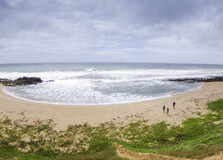
Sodwana Bay National Park, located in the province of KwaZulu-Natal in South Africa, is a popular destination for nature lovers and outdoor enthusiasts. The park is known for its stunning marine biodiversity, crystal-clear waters, and pristine beaches. With its diverse ecosystems, Sodwana Bay National Park offers visitors a chance to explore and appreciate the natural beauty of the region. Location and Geographical Overview Sodwana Bay National Park is situated along the east coast of South Africa, near the border of Mozambique. The park covers an area of approximately 100 km² and is part of the iSimangaliso Wetland Park, a UNESCO World Heritage Site. The park is renowned for its coral reefs, which are some of the southernmost coral reefs in the world, making it a popular destination for scuba diving and snorkeling enthusiasts. Opening and Closing Time The park is open daily from 7:00 am to 5:00 pm. Entry Fee The entry fee for Sodwana Bay National Park varies depending on the age and residency status of the visitor. South African residents can expect to pay a lower fee compared to international visitors. Species-Flora/Fauna Availability Sodwana Bay National Park is home to a wide variety of plant and animal species. The park's coastal forests and dune vegetation provide habitat for numerous bird species, while the marine environment supports a diverse array of marine life, including colorful fish, dolphins, and even whale sharks. Activities Performed Visitors to Sodwana Bay National Park can enjoy a range of activities, including scuba diving, snorkeling, swimming, hiking, birdwatching, and beachcombing. The park's clear waters and vibrant coral reefs make it a popular destination for underwater exploration, while its sandy beaches offer the perfect spot for relaxation and sunbathing. Jeep Safari Charges There are no jeep safari charges at Sodwana Bay National Park. However, visitors can explore the park's diverse ecosystems and wildlife by foot or on guided tours. Age Criterion for Male, Female, Children and Their Entry Fee The entry fee for Sodwana Bay National Park is typically divided into categories based on age and residency status. Children under a certain age may be eligible for free entry, while adults and senior citizens may be required to pay a nominal fee. Female and male visitors are typically charged the same entry fee. Senior Citizen Facilities Sodwana Bay National Park offers facilities for senior citizens, including accessible trails, rest areas, and designated parking spaces. Visitors are encouraged to inquire about special accommodations for senior citizens at the park's entrance gate. Best Time to Visit The best time to visit Sodwana Bay National Park is during the dry season, which typically occurs from April to September. The weather is cooler and drier during this time, making it ideal for outdoor activities such as diving, snorkeling, and hiking. Visitors should be aware that the park can be busy during peak tourist seasons, so it is advisable to book accommodations and activities in advance. Nearby Places to Visit There are several nearby attractions that visitors to Sodwana Bay National Park may want to explore, including the iSimangaliso Wetland Park, Mabibi Beach, and Lake Sibaya. These areas offer additional opportunities for wildlife viewing, water sports, and cultural experiences. Vehicle Parking Facility Sodwana Bay National Park offers ample parking facilities for visitors with personal vehicles. There are designated parking areas located near the park entrance, as well as within the park grounds. Visitors are advised to follow the park's parking regulations and guidelines to ensure the safety and security of their vehicles. Rules and Regulations Visitors to Sodwana Bay National Park are required to abide by certain rules and regulations to help protect the park's natural resources and wildlife. Some common regulations include no littering, no feeding of wildlife, no removal of plants or animals, and no unauthorized camping. It is important for visitors to familiarize themselves with the park rules before entering the park. How to Reach and Other Related Information Sodwana Bay National Park can be reached by road from major cities such as Durban and Johannesburg. The park is approximately a four to six-hour drive from Durban, depending on traffic conditions. Visitors can also fly to nearby airports, such as Richards Bay Airport or King Shaka International Airport, and rent a car to drive to the park. For more information on visiting Sodwana Bay National Park, including accommodation options, activities, and park regulations, visitors can contact the park office or visit the official park website.
Explore More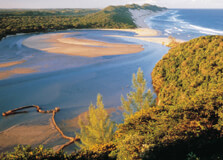
iSimangaliso Wetland Park is one of the most breathtaking natural treasures of South Africa, located in the KwaZulu-Natal province on the country’s northeastern coast. This UNESCO World Heritage Site stretches over 3,280 square kilometers and features a remarkable blend of ecosystems, including coral reefs, lakes, coastal forests, wetlands, and savannas. It is South Africa’s first World Heritage Site, declared in 1999, and remains a popular destination for nature enthusiasts, wildlife lovers, and adventure seekers. The park's name "iSimangaliso" means "miracle and wonder" in Zulu, and it truly lives up to this title. From whales and dolphins along the coast to hippos and crocodiles in the estuaries, and rare bird species overhead, iSimangaliso offers one of the most diverse and spectacular wildlife experiences in Africa. How to Reach iSimangaliso Wetland Park, KwaZulu-Natal By Air: The closest major airport is King Shaka International Airport in Durban, which is about 275 km from the park. From the airport, you can rent a car or take a private transfer to the park. By Road: The most common route is to drive from Durban to the town of St Lucia, which serves as the main gateway to the southern part of the park. The drive takes around 3 hours via the N2 highway. By Tour Packages: Several travel agencies offer guided tours and safari packages from Durban or Richards Bay to iSimangaliso, often including transport, meals, and park activities. Weather in iSimangaliso Wetland Park iSimangaliso has a subtropical climate, making it a year-round destination. Summer (November to March): Hot and humid with average temperatures around 30°C (86°F). Rain showers are more frequent during this period, mainly in the form of afternoon thunderstorms. Winter (May to August): Mild and dry, with daytime temperatures ranging from 20°C to 25°C (68°F to 77°F). Nights can be cooler. The dry winter months are generally preferred for wildlife viewing, while the summer months are ideal for birdwatching and marine activities. Park Timings The park is open year-round, with daily operational hours from 6:00 AM to 6:00 PM for most entrances. Some areas may have specific timing variations, so it’s best to confirm when booking tours or accommodations. Entry after hours is not permitted unless you are staying in the park at an official lodge or camp. Why KwaZulu-Natal is Famous KwaZulu-Natal is famous for its rich cultural heritage, especially as the home of the Zulu kingdom, as well as for its scenic beauty that ranges from coastal beaches to the Drakensberg Mountains. It is also known for excellent wildlife reserves, traditional craft markets, and adventure sports. iSimangaliso Wetland Park is one of the crown jewels of this province and attracts thousands of tourists every year. Entry and Visit Details about iSimangaliso Wetland Park The park consists of several distinct sections, including Lake St Lucia, Cape Vidal, Sodwana Bay, uMkhuze Game Reserve, and Kosi Bay. Most visitors begin at the St Lucia entrance. Entry Fees: Entry costs around ZAR 50–70 per adult per day for South Africans, and around ZAR 200 for international tourists. Fees vary slightly by section. Accommodation: Ranges from luxury lodges and beachfront chalets to budget backpackers and campsites. Early booking is recommended during holidays. Park permits are often required for specific activities like boat cruises, snorkeling, and turtle tours. History and Architecture of iSimangaliso Wetland Park iSimangaliso’s heritage dates back thousands of years with archaeological evidence of human settlements. The park gained international recognition when it was listed as a World Heritage Site in 1999 due to its ecological significance and diverse habitats. There is no monumental architecture in the park; instead, the “architecture” is found in the natural forms—sand dunes, coral reefs, and papyrus swamps. Visitor centers and lodges are built using eco-friendly materials and designed to harmonize with the surrounding environment. Things to Do in iSimangaliso Wetland Park Game Drives: Spot elephants, buffaloes, leopards, rhinos, and antelopes in the uMkhuze and Western Shores sections. Boat Cruises: Take guided estuary tours from St Lucia to see hippos, crocodiles, and waterbirds. Snorkeling and Diving: Explore coral reefs at Sodwana Bay, one of the world’s best dive sites. Turtle Tours: During summer, join guided night walks to see loggerhead and leatherback turtles nesting along the beach. Bird Watching: With over 500 species, it's a top destination for bird lovers. Kayaking and Canoeing: Explore mangroves and lakes under the guidance of experienced paddlers. Beach Activities: Relax, swim, or fish at Cape Vidal and Kosi Bay beaches. Interesting Facts About iSimangaliso Wetland Park The park supports over 6,500 plant and animal species. It includes Africa’s largest estuarine system—Lake St Lucia. It’s one of the few places where you can see elephants, whales, and dolphins in a single day. The park is a critical nesting site for endangered sea turtles. Formerly known as the Greater St Lucia Wetland Park, it was renamed to reflect local heritage. Tips for Visiting iSimangaliso Wetland Park Wear sun protection—hats, sunscreen, and sunglasses are essential. Carry binoculars for birdwatching and a camera for wildlife photography. Stay on designated paths and respect wildlife from a distance. Booking guided tours can enhance your understanding of the ecosystems. Insect repellent is recommended, especially in summer months. If diving, check tides and visibility conditions beforehand. Don’t feed wild animals, even if they approach your vehicle or camp. iSimangaliso Wetland Park is a must-visit destination for anyone who wants to experience South Africa’s natural beauty and ecological wonders. With its unmatched diversity and tranquil landscapes, the park offers something for everyone—from thrilling outdoor adventures to peaceful moments in nature.
Explore More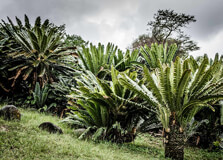
The Modjadji Cycad Reserve is a botanical garden located in Limpopo, South Africa. It is home to the largest concentration of a single cycad species in the world, the Modjadji cycad, also known as the African cycad. Location and Geographical Overview The Modjadji Cycad Reserve is situated near the town of Tzaneen in the Limpopo province of South Africa. It covers an area of approximately 60 hectares and is known for its lush vegetation and unique cycad species. Open and Closing Time The Modjadji Cycad Reserve is open to visitors from 8:00 am to 4:00 pm daily. It is closed on certain public holidays, so it is recommended to check the schedule before planning your visit. Entry Fee There is an entry fee to access the Modjadji Cycad Reserve. The fee is affordable and varies depending on age and group size. Children under a certain age may enter for free. Species-Flora/Fauna Availability The Modjadji Cycad Reserve is home to a diverse range of flora and fauna. In addition to the Modjadji cycad, visitors can also see various bird species, insects, and small mammals in the reserve. Activities Performed Visitors to the Modjadji Cycad Reserve can enjoy a range of activities, including guided walking tours, birdwatching, picnicking, and nature photography. The reserve is a great place for nature enthusiasts to explore and appreciate the unique plant life. Jeep Safari Charges For those looking for a more adventurous experience, jeep safaris are also available at the Modjadji Cycad Reserve. The safari charges are separate from the entry fee and offer visitors the opportunity to explore the reserve in a more immersive way. Age Criterion for Male, Female, Children and Their Entry Fee There may be specific age criteria for entry fees at the Modjadji Cycad Reserve. Typically, children under a certain age may enter for free, while adults and seniors may have different pricing tiers. It is best to check the current fee structure before visiting. Senior Citizen Facilities The Modjadji Cycad Reserve may offer special facilities for senior citizens, such as discounted entry fees, wheelchair accessibility, or guided tours tailored to their needs. It is recommended to inquire about these facilities when booking your visit. Best Time to Visit The best time to visit the Modjadji Cycad Reserve is during the spring and summer months when the cycads are in full bloom. The weather is pleasant, and the reserve is teeming with vibrant plant life and wildlife during this time. Nearby Places to Visit While in the area, visitors can also explore other attractions near the Modjadji Cycad Reserve, such as the Modjadji Nature Reserve, Agatha Crocodile Ranch, Debengeni Waterfalls, and the picturesque town of Tzaneen. Vehicle Parking Facility The Modjadji Cycad Reserve offers ample parking facilities for visitors arriving by car. There may be designated parking areas near the entrance of the reserve for convenience and safety. Rules and Regulations Visitors to the Modjadji Cycad Reserve are expected to follow certain rules and regulations to preserve the natural environment and ensure the safety of all guests. Some common rules include staying on designated paths, not littering, and respecting wildlife. How to Reach and Other Related Information The Modjadji Cycad Reserve is easily accessible by car from major cities in South Africa, such as Johannesburg and Pretoria. Visitors can also reach the reserve via public transportation or organized tours. It is recommended to book in advance and check the current operating hours before planning your visit. Overall, the Modjadji Cycad Reserve offers a unique and enriching experience for nature lovers and outdoor enthusiasts. With its diverse plant life, guided tours, and various activities, it is a must-visit destination for anyone exploring the natural beauty of South Africa's Limpopo province.
Explore MoreLuxury South African Safari
7 Days/ 6 Night
Limpopo - Johannesburg - Kapama
10 Day Youth Leadership Tour Itinerary For South Africa
10 Days/ 9 Night
Cape Town - Johannesburg
30 Days Volunteer Program South Africa Tour
30 Days/ 29 Night
Garden Route - Cape Town - Johannesburg
Special Needs Family Tour - Cape Town
8 Days/ 7 Night
Cape Town
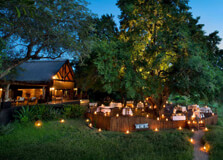
About Sabi Sands Game Reserve The Sabi Sands Game Reserve is a 65,000-hectare private game reserve located in the Mpumalanga province of South Africa. It shares an unfenced border with the renowned Kruger National Park, allowing for the free movement of wildlife between the two reserves. The Sabi Sands Game Reserve is known for its exceptional Big Five game viewing opportunities, making it a popular destination for wildlife enthusiasts and safari-goers. Location and Geographical Overview The Sabi Sands Game Reserve is situated in the southern part of the Kruger National Park, near the town of Skukuza. The reserve is characterized by a diverse landscape of savannah grasslands, riverine forests, and rocky outcrops, providing a variety of habitats for a wide range of wildlife species. Open and Closing Time The Sabi Sands Game Reserve is open for visitors from sunrise to sunset. The exact opening and closing times may vary depending on the season and weather conditions. It is always recommended to check with the reserve authorities for the latest information on operating hours. Entry Fee The entry fee for the Sabi Sands Game Reserve varies depending on the type of safari experience you choose. There are different packages available, including day safaris, overnight stays, and guided tours. It is advisable to book in advance to secure your spot and avoid any disappointments. Species - Flora/Fauna Availability The Sabi Sands Game Reserve is home to a wide variety of flora and fauna species. The reserve is particularly known for its abundant wildlife populations, including the Big Five (elephant, rhinoceros, buffalo, lion, and leopard). In addition to the iconic Big Five, visitors can also expect to see a variety of antelope, birds, reptiles, and other wildlife species during their safari experience. Activities Performed Visitors to the Sabi Sands Game Reserve can enjoy a range of activities, including game drives, bush walks, bird watching, and photographic safaris. The reserve offers guided tours led by experienced rangers and trackers who provide valuable insights into the local wildlife and ecosystem. Jeep Safari Charges The cost of a jeep safari in the Sabi Sands Game Reserve typically varies depending on the length of the safari, the number of participants, and the type of safari package chosen. It is recommended to inquire about the current rates and availability when booking your safari experience. Age Criterion for Male, Female, Children, and their Entry Fee The Sabi Sands Game Reserve welcomes visitors of all ages, with specific age criteria and entry fees for male, female, and children. Children under a certain age may be required to be accompanied by an adult during the safari activities. It is advisable to check with the reserve authorities for the specific age requirements and entry fees. Senior Citizen Facilities The Sabi Sands Game Reserve provides facilities and services to cater to senior citizens, including accessible accommodations, safari vehicles, and guided tours. Special arrangements can also be made to accommodate any mobility or health-related needs of senior visitors. It is recommended to inform the reserve staff in advance to ensure a comfortable and enjoyable safari experience. Best Time to Visit The best time to visit the Sabi Sands Game Reserve is during the dry season from May to September when wildlife viewing is at its peak. The cooler temperatures and sparse vegetation during this time make it easier to spot animals in their natural habitat. However, the reserve is open year-round, and each season offers unique opportunities for safari enthusiasts. Nearby Places to Visit There are several other attractions and points of interest near the Sabi Sands Game Reserve that visitors can explore during their stay. Nearby attractions include the Kruger National Park, Blyde River Canyon, Panorama Route, and various cultural and historical sites. It is recommended to plan ahead and include these nearby places in your itinerary for a comprehensive safari experience. Vehicle Parking Facility The Sabi Sands Game Reserve provides designated parking areas for visitors who arrive by their own vehicles. The parking facilities are safe and secure, allowing visitors to leave their vehicles while they enjoy their safari experience. It is advisable to follow the parking regulations and guidelines provided by the reserve authorities to ensure the safety of your vehicle. Rules and Regulations When visiting the Sabi Sands Game Reserve, it is important to follow the rules and regulations set forth by the reserve authorities to ensure the safety of visitors and wildlife. Some common rules include respecting the wildlife and their natural habitat, obeying the instructions of the rangers and guides, and refraining from littering or disturbing the environment. It is essential to be mindful of the rules and regulations to preserve the integrity of the reserve for future generations. How to Reach and Other Related Information The Sabi Sands Game Reserve is easily accessible by road from major cities and airports in South Africa. Visitors can also opt for chartered flights or transfers to reach the reserve. It is recommended to make transportation arrangements in advance to ensure a smooth and hassle-free journey to the reserve. For more information on how to reach the Sabi Sands Game Reserve and related travel tips, visitors can contact the reserve authorities or consult with their tour operators.
Explore More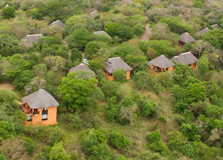
Hluhluwe–iMfolozi Park is the oldest proclaimed game reserve in Africa, located in the KwaZulu-Natal province, approximately 250 kilometers north of Durban. The park is renowned for its rich wildlife, scenic landscapes, and historical conservation efforts, particularly the protection of the white rhino. Spanning over 96,000 hectares, the park combines two previously separate reserves — Hluhluwe in the north and iMfolozi in the south — offering diverse ecosystems and excellent wildlife viewing opportunities. Visitors can enjoy sightings of the Big Five (elephant, rhino, lion, leopard, and buffalo), as well as cheetahs, hyenas, giraffes, and over 340 species of birds. With its lush green hills, valleys, and rivers, Hluhluwe–iMfolozi is a prime safari destination in South Africa and a must-visit for nature lovers. How to Reach Hluhluwe–iMfolozi Park, Durban By Air: The nearest major airport is King Shaka International Airport in Durban. From the airport, travelers can rent a car or book a transfer service to reach the park. By Road: Hluhluwe–iMfolozi Park is about a 3-hour drive (roughly 250 km) from Durban via the N2 highway. The roads are well-maintained and clearly signposted, making self-driving convenient and safe. By Tour: Many Durban-based tour companies offer guided day tours or overnight safari packages that include transportation, meals, and game drives. Weather in Hluhluwe–iMfolozi Park Hluhluwe–iMfolozi Park has a subtropical climate, making it accessible year-round. Summer (November to March): Warm to hot temperatures, often reaching up to 35°C (95°F), with occasional afternoon thunderstorms. The landscape is lush and green. Winter (May to August): Mild days and cool nights with temperatures ranging from 10°C to 25°C (50°F to 77°F). This is the best time for game viewing as animals gather near water sources. Park Timings The park is open every day, including public holidays. Summer (Nov – Feb): 5:00 AM – 7:00 PM Winter (May – Aug): 6:00 AM – 6:00 PM Visitors are advised to arrive early in the morning for the best wildlife viewing. Late arrivals may not be allowed entry near closing time. Why Durban is Famous Durban is a major city on South Africa’s east coast, famous for its golden beaches, warm Indian Ocean waters, vibrant Zulu culture, and delicious Indian-influenced cuisine. It serves as a popular starting point for safari adventures due to its well-connected transport system and proximity to wildlife parks like Hluhluwe–iMfolozi. The city also hosts cultural festivals, beachfront promenades, and the famous uShaka Marine World. Entry and Visit Details for Hluhluwe–iMfolozi Park Entry Fees (approx.): International Adults: R240 per person per day South African Residents: R60 per adult with valid ID Children under 12: Discounted rates available Fees are payable at the gates or can be booked online through the Ezemvelo KZN Wildlife website. Visitors can enter the park via the Memorial Gate (north), Nyalazi Gate (central), or Cengeni Gate (south). Overnight options range from self-catering lodges and bush camps to luxury safari accommodations within and near the park. History and Architecture of Hluhluwe–iMfolozi Park The park dates back to 1895, making it Africa’s oldest wildlife reserve. It played a crucial role in the preservation of the southern white rhinoceros, thanks to Operation Rhino in the 1950s and 60s, which helped save the species from near extinction. The architecture within the park blends into the natural surroundings, with lodges and camps built using locally sourced materials. Most accommodations are eco-friendly, with thatched roofs, stone walls, and wooden decks that provide panoramic views of the wilderness. Things to Do in Hluhluwe–iMfolozi Park Game Drives: Self-drive or guided drives to spot the Big Five and other wildlife. Guided Bush Walks: Experience the bush on foot with a trained ranger and learn about the flora and fauna. Bird Watching: With over 340 bird species, it's a paradise for bird lovers. Photography: Stunning landscapes and wildlife make for incredible photo opportunities. Picnic Areas: Designated spots for picnicking and relaxing with family or friends. Cultural Tours: Nearby Zulu villages offer cultural experiences and handicraft shopping. Interesting Facts About Hluhluwe–iMfolozi Park The park helped bring the white rhino population back from fewer than 100 to thousands worldwide. It was once a royal hunting ground for Zulu kings such as Shaka Zulu. It contains Africa’s oldest game capture unit, used to relocate animals for conservation. It's one of the few parks where you can enjoy walking safaris in Big Five territory. The park's name is pronounced “Shloo-shloo-way ee-mm-foh-loh-zee.” Tips for Visiting Hluhluwe–iMfolozi Park Start your game drives early in the morning or late in the afternoon for the best wildlife activity. Drive slowly and keep your windows down to listen for animal sounds and bird calls. Bring binoculars, sunscreen, insect repellent, and plenty of water. Wear neutral-colored clothing to blend into the surroundings. Do not exit your vehicle except at designated areas. Book accommodation and guided tours in advance, especially during peak seasons. Check the weather forecast and gate closing times before planning your visit. Hluhluwe–iMfolozi Park is a remarkable destination that combines history, conservation, and adventure. Whether you're a first-time visitor or a seasoned traveler, this park offers a rich and immersive wildlife experience just a few hours from Durban. It’s a place where nature, culture, and history come together to create unforgettable memories.
Explore More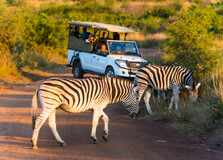
Pilanesberg National Park, located near Johannesburg, South Africa, is one of the country’s most popular wildlife conservation areas. Established in 1979, it is situated within the crater of an extinct volcano, offering unique topography and a stunning landscape. The park covers an area of 55,000 hectares and is home to a wide variety of wildlife, including the Big Five—lion, leopard, elephant, buffalo, and rhinoceros. It also features a rich diversity of plant and bird species, making it a prime destination for nature lovers and safari enthusiasts. Why is Pilanesberg National Park Famous? Pilanesberg National Park is renowned for its diversity of wildlife and its unique geological features. Its location in the crater of an ancient volcano provides spectacular views and an interesting geological landscape. The park is also famous for being home to the Big Five, making it a top safari destination. Besides the Big Five, the park also hosts a wide range of animals such as cheetahs, giraffes, zebras, and hippos, as well as over 360 bird species, making it a haven for wildlife photographers and birdwatchers. The park's commitment to conservation is another reason for its popularity. It is part of the larger Pilanesberg Biosphere, which is dedicated to protecting the region's natural heritage and wildlife. It was established as a game reserve after the area was demined and rehabilitated, giving a second life to the region’s natural environment. How to Reach Pilanesberg National Park, Johannesburg Pilanesberg National Park is situated approximately 2.5 hours north of Johannesburg, making it easily accessible by car. The park is located near the town of Sun City, which is a popular resort area in the North West Province. To reach the park from Johannesburg, take the N4 highway heading west, then follow the R565 road to Pilanesberg. The journey offers scenic views of the South African countryside. If you prefer not to drive, there are shuttle services and guided tours available from Johannesburg to the park, especially from popular tourist spots like Sun City. Alternatively, you can also fly into the nearby Pilanesberg International Airport, which is about a 20-minute drive from the park. This option is ideal for those who are looking for a quicker way to reach the area. Weather in Pilanesberg National Park Pilanesberg National Park experiences a temperate climate, with hot summers and mild winters. Summer (from November to February) temperatures can range from 25°C to 35°C (77°F to 95°F), with occasional thunderstorms in the afternoons. Winter (from June to August) is cooler, with temperatures ranging from 5°C to 22°C (41°F to 72°F). Early mornings and evenings can be chilly during winter, so it's advisable to dress in layers. The best time to visit the park is during the dry winter months, from May to September, when the animals tend to gather around the remaining water sources, making wildlife viewing easier. However, visiting during the summer months is also rewarding, with lush landscapes and the chance to witness newborn animals. Opening Hours and Timing Pilanesberg National Park is open every day of the year, allowing visitors to enjoy its beauty and wildlife year-round. The park’s opening hours are typically as follows: Gate opening time: 5:30 AM Gate closing time: 6:30 PM (summer) / 6:00 PM (winter) It is recommended to enter the park early in the morning for the best chance to spot wildlife, as many animals are more active during the cooler hours of the day. If you’re planning to visit the park’s popular viewpoints, morning visits are especially rewarding, as the landscape is often bathed in soft early morning light. Entry and Visit Details about Pilanesberg National Park The park charges an entry fee for visitors, which is generally quite affordable. The fees vary depending on whether you are a South African citizen, a resident of a Southern African country, or an international tourist. Entry fees help maintain the park's infrastructure and support conservation efforts. The general entry fees are: South African citizens: 80 ZAR (adults), 40 ZAR (children) Residents of Southern African countries: 150 ZAR (adults), 75 ZAR (children) International tourists: 250 ZAR (adults), 125 ZAR (children) Once inside, visitors can enjoy self-guided drives or opt for a guided safari tour to explore the park. The park has well-maintained roads for self-drive safaris, and numerous strategically placed viewing points offer excellent opportunities to spot wildlife. History and Architecture of Pilanesberg National Park Pilanesberg National Park was established in 1979 in an area once used for agriculture. Its creation was part of a broader conservation initiative to restore the region’s wildlife and ecosystems. The park was built on the site of an ancient volcano, which adds to the geological significance of the area. The landscape is marked by rocky outcrops, rolling hills, and waterholes, all of which offer visitors spectacular views of the park's natural beauty. The park has undergone significant rehabilitation, including demining efforts to remove the remnants of past conflicts, and the restoration of natural habitats. It is now one of South Africa’s premier conservation areas, offering a home to over 7,000 animals across more than 35 species of mammals, and numerous bird species. Things to Do at Pilanesberg National Park There are plenty of activities to enjoy at Pilanesberg National Park, making it a fantastic destination for wildlife enthusiasts, nature lovers, and families. Some of the most popular activities include: Safari Drives: Whether you’re on a self-drive safari or a guided tour, the park offers incredible opportunities to observe wildlife in their natural habitat. Guided tours often come with experienced rangers who provide valuable insights into animal behavior and park conservation efforts. Hot Air Ballooning: For a truly unique experience, you can take a hot air balloon ride over the park, offering breathtaking aerial views of the wildlife and landscapes below. Birdwatching: With over 360 species of birds, Pilanesberg is a great destination for birdwatching. Keep an eye out for raptors like eagles, vultures, and various species of hornbills. Picnicking and Scenic Drives: The park has several picnic spots and scenic viewpoints, making it an ideal place to enjoy a meal surrounded by nature. Facts About Pilanesberg National Park The park is situated within the crater of an extinct volcano, which is approximately 1.2 billion years old. It is home to a diverse range of wildlife, including the Big Five: lion, elephant, leopard, buffalo, and rhinoceros. The park’s terrain is unique, with varying landscapes such as grassy plains, forests, and rocky hills. Pilanesberg is also home to the endangered wild dog and the rare cheetah. Tips for Visiting Pilanesberg National Park Bring a Good Camera: The park offers incredible opportunities for photography, so be sure to bring a camera with a good zoom lens to capture the wildlife. Stay Hydrated: The sun can be intense, especially during summer, so remember to carry water and stay hydrated throughout your visit. Dress for Comfort: Wear comfortable clothes and shoes, particularly if you plan to explore on foot or take a long safari drive. Respect Wildlife: Always keep a safe distance from animals and follow the park’s rules regarding wildlife observation. Conclusion Pilanesberg National Park is a must-visit destination for nature lovers and wildlife enthusiasts. With its diverse ecosystems, abundance of wildlife, and unique geological features, the park offers a memorable and enriching experience. Whether you’re interested in a safari adventure, birdwatching, or simply enjoying the beauty of the South African landscape, Pilanesberg National Park is a perfect getaway for anyone seeking a closer connection with nature.
Explore More
Eden to Addo Biodiversity Corridor
The Eden to Addo Biodiversity Corridor is a conservation initiative located in the Garden Route region of South Africa. Stretching from the Western Cape to the Eastern Cape, this corridor aims to protect and enhance the biodiversity of the area through various conservation efforts. Location and Geographical Overview The corridor covers a vast area spanning across different ecosystems including fynbos, forest, and coastal areas. It is home to a wide variety of plant and animal species, making it a hotspot for biodiversity. Open and Closing Time The corridor is open daily from 8:00 am to 5:00 pm. Entry Fee There is no entry fee to access the corridor. However, donations are encouraged to support the conservation efforts. Species-Flora/Fauna Availability The corridor is home to a diverse range of flora and fauna, including proteas, fynbos, elephants, Cape mountain zebras, and various bird species. Activities Performed Visitors can enjoy activities such as hiking, birdwatching, and guided jeep safaris to explore the biodiversity of the corridor. Jeep Safari Charges The charges for a guided jeep safari tour vary depending on the duration and the specific route chosen. It is recommended to inquire about the current rates at the visitor center. Age Criterion for Male, Female, Children and their Entry Fee There is no specific age criterion for entry to the corridor. Visitors of all ages are welcome to explore the area. Children under a certain age may need to be accompanied by an adult. Senior Citizen Facilities The corridor provides facilities for senior citizens, including benches and rest areas along the trails for them to take a break and enjoy the surroundings. Best Time to Visit The best time to visit the Eden to Addo Biodiversity Corridor is during the spring months (September to November) when the flora is in full bloom and the weather is pleasant for outdoor activities. Nearby Places to Visit There are several other attractions in the Garden Route region that visitors can explore, including Tsitsikamma National Park, Knysna Elephant Park, and Plettenberg Bay. Vehicle Parking Facility The corridor has designated parking areas for visitors to park their vehicles while exploring the area on foot or participating in activities. Rules and Regulations Visitors are required to follow the rules and regulations of the corridor, including staying on designated trails, not feeding wildlife, and respecting the environment and other visitors. How to Reach and Other Related Information The Eden to Addo Biodiversity Corridor can be accessed by car from major cities like Cape Town and Port Elizabeth. Visitors can also opt for guided tours or public transportation to reach the corridor. It is recommended to check the official website for the latest information on facilities, activities, and any updates on regulations.
Explore More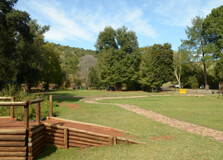
Groenkloof Nature Reserve is one of the most beautiful and oldest nature reserves in Pretoria, South Africa. It covers an area of about 600 hectares and is known for its rich biodiversity and tranquil environment. Situated just a few kilometers from the city center, it provides a serene escape for those wanting to enjoy outdoor activities such as hiking, birdwatching, and wildlife viewing. Groenkloof Nature Reserve is one of Pretoria’s most beloved green spaces, offering visitors a chance to connect with nature while still being close to the city’s hustle and bustle. History of Groenkloof Nature Reserve Groenkloof Nature Reserve has a significant place in the history of South Africa’s conservation efforts. It was established in 1895, making it one of the oldest nature reserves in the country. Originally, the area was set up to protect the indigenous vegetation and animals from urban expansion. In its early years, Groenkloof was used for hunting purposes, but as time passed, the reserve shifted towards a conservation and recreational role. In the mid-20th century, Groenkloof Nature Reserve became more formally recognized as a nature reserve and began to offer recreational and educational opportunities to the public. It was also in this period that efforts to conserve endangered species and restore the natural ecosystem began. Over the years, the reserve has grown in both size and importance, playing a vital role in educating visitors about environmental preservation and wildlife conservation. Why is Groenkloof Nature Reserve Famous? Groenkloof Nature Reserve is famous for being one of Pretoria's first and oldest nature reserves. It is home to a variety of wildlife, including zebra, impala, kudu, and a range of bird species. Its diverse habitats, which include grasslands, forests, and wetlands, make it a popular destination for nature lovers and wildlife enthusiasts. Groenkloof is also well-known for its excellent walking trails and its proximity to the city, making it easily accessible to visitors seeking a quick nature escape. Another reason for its fame is the presence of the Groenkloof Elephant Sanctuary. The sanctuary plays a major role in educating visitors about elephant conservation and providing them with an opportunity to learn about these magnificent creatures. Visitors can observe elephants in their natural habitat and interact with them in a controlled, educational environment. The sanctuary is an integral part of Groenkloof Nature Reserve, attracting visitors from all over the world. How to Reach Groenkloof Nature Reserve Groenkloof Nature Reserve is located in the southern part of Pretoria, just a short drive from the city center. It is easily accessible by car, taxi, or ride-sharing services such as Uber. The reserve is situated off the M1 road (Johan Rissik Drive), which is a central route in Pretoria, making it a convenient destination for both locals and tourists. The entrance to the reserve is well-marked, so it is easy to find once you are in the area. If you are using public transportation, taxis and buses serve the area, but the bus station may require a short walk to reach the entrance of the reserve. For those who are staying in central Pretoria, Groenkloof is just 15-20 minutes by car, depending on traffic. Weather in Groenkloof Nature Reserve Groenkloof Nature Reserve experiences a subtropical climate with warm summers and mild winters. The summer months, from November to March, can be quite hot, with temperatures averaging between 25°C and 35°C (77°F to 95°F). During this time, afternoon thunderstorms are common, providing some relief from the heat. Visitors during the summer months should bring sunscreen, wear light clothing, and stay hydrated while exploring the reserve. Winter, from May to August, is much milder with daytime temperatures ranging from 10°C to 20°C (50°F to 68°F), but it can be cooler in the mornings and evenings. The winter months are considered an ideal time for hiking, as the weather is sunny and pleasant, making it an excellent time to explore the reserve without the extreme heat of summer. Visitors should bring a warm jacket or sweater for the evenings, but daytime activities are generally comfortable. Timing and Opening Hours Groenkloof Nature Reserve is open to the public every day of the week, from 6:00 AM to 6:00 PM. These hours provide ample time for visitors to enjoy various activities such as hiking, biking, and wildlife viewing. The early morning hours are especially popular for birdwatching, as many bird species are more active during the cooler parts of the day. The reserve remains open throughout the year, so visitors can explore its natural beauty regardless of the season. However, it is advisable to check for any special events or maintenance closures before planning a visit, as the reserve occasionally hosts educational programs or wildlife conservation activities. Entry and Visit Details Entry to Groenkloof Nature Reserve is affordable, with a small fee that contributes to the upkeep of the park. The typical entrance fee is about 40 ZAR for adults, with discounts available for children and students. The reserve also offers group rates for schools and organizations looking to visit for educational purposes. Although the entry fee is quite modest, it is always a good idea to check for any changes in fees or special events before you visit. For those interested in a guided experience, the reserve offers educational tours led by knowledgeable guides. These tours provide insights into the reserve’s wildlife, plant life, and conservation efforts. It is advisable to book guided tours in advance, especially during busy tourist seasons, to ensure availability. Things to Do in Groenkloof Nature Reserve Groenkloof Nature Reserve offers a wide range of activities for visitors. Some of the top things to do include: Hiking: The reserve features several well-marked hiking trails that cater to different fitness levels. The trails allow visitors to explore the diverse landscapes of the reserve, including grasslands, woodlands, and wetlands. The trails are ideal for nature walks, birdwatching, and enjoying the scenic beauty of the area. Wildlife Viewing: Groenkloof is home to a variety of wildlife, including zebra, impala, blesbok, and kudu. Visitors can observe these animals in their natural habitat while walking along the trails. The reserve also offers great opportunities for birdwatching, with over 200 species of birds recorded in the area. Mountain Biking: For cyclists, the reserve offers several mountain biking trails. These trails offer a bit more adventure for cycling enthusiasts, providing a challenging yet enjoyable experience. Bikes are available for rent at the reserve. Groenkloof Elephant Sanctuary: One of the highlights of Groenkloof Nature Reserve is the Groenkloof Elephant Sanctuary. The sanctuary is home to rescued elephants and provides visitors with the opportunity to learn about elephant conservation. You can even interact with the elephants and watch them roam freely in their natural environment. Picnicking: While there are no formal picnic areas in Groenkloof Nature Reserve, the tranquil environment makes it a great place for a picnic. Visitors often bring their own food and enjoy a peaceful meal in the midst of nature. Facts About Groenkloof Nature Reserve Groenkloof Nature Reserve was established in 1895, making it one of the oldest nature reserves in South Africa. The reserve covers an area of approximately 600 hectares and is home to a wide variety of wildlife, including zebra, impala, blesbok, and kudu. It is also a great destination for birdwatching, with over 200 bird species recorded in the reserve. Groenkloof is known for its diverse landscapes, which include grasslands, woodlands, and wetlands, providing various ecosystems for wildlife and plant life. The reserve offers activities such as hiking, mountain biking, wildlife viewing, and visits to the Groenkloof Elephant Sanctuary. Tips for Visiting Groenkloof Nature Reserve Wear comfortable footwear: Since hiking is a popular activity at the reserve, it is essential to wear sturdy, comfortable shoes. Bring water and sunscreen: It’s important to stay hydrated and protect yourself from the sun, especially during the warmer months. Respect wildlife: Keep a safe distance from the animals and avoid feeding them. This helps ensure both your safety and the well-being of the wildlife. Check the weather forecast: Be prepared for afternoon thunderstorms in the summer months. It’s advisable to bring a light rain jacket if you plan to visit during the rainy season. Plan ahead: Make sure to check for any events or closures before visiting, especially during peak seasons. Conclusion Groenkloof Nature Reserve is a must-visit destination for anyone interested in nature, wildlife, and outdoor activities in Pretoria. With its rich history, diverse wildlife, and wide range of activities, it offers something for everyone. Whether you're hiking through its scenic trails, watching wildlife, or visiting the Groenkloof Elephant Sanctuary, the reserve provides an excellent opportunity to enjoy the beauty of South Africa’s natural heritage.
Explore More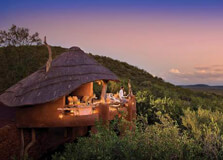
Madikwe Game Reserve is one of South Africa’s largest and most exclusive wildlife reserves, located in the North West Province, close to the Botswana border. Though not directly in Pretoria, it is commonly accessed via the city due to its convenient location. Covering approximately 75,000 hectares, Madikwe is a malaria-free safari destination known for its incredible wildlife diversity, luxurious lodges, and conservation success. What makes Madikwe unique is its community-based conservation model and the opportunity to see the Big Five (lion, leopard, elephant, buffalo, and rhino) along with rare species such as African wild dogs and cheetahs. The reserve provides a peaceful, uncrowded safari experience and is especially suited for families and first-time safari-goers. How to Reach Madikwe Game Reserve, Pretoria By Road: Madikwe is about a 4 to 5-hour drive (approximately 350 km) from Pretoria. The route via N4 and R49 highways is scenic and well-maintained. Private vehicles or rental cars are commonly used, but transfers can also be arranged through safari lodges or tour operators. By Air: Scheduled charter flights operate from OR Tambo International Airport in Johannesburg to Madikwe’s airstrip. The flight duration is around 1 hour. Helicopter transfers can also be arranged for a luxurious experience. By Tour: Many tour operators in Pretoria offer package safaris to Madikwe, including transport, accommodation, and guided game drives. Weather in Madikwe Game Reserve Madikwe has a semi-arid climate, offering distinct wet and dry seasons: Summer (November – March): Warm to hot, with temperatures reaching up to 35°C (95°F). Afternoon showers are common but usually short. The landscape is green, and many animals give birth during this season. Winter (May – August): Dry and cooler, with daytime temperatures between 17°C and 25°C (63°F – 77°F) and chilly mornings and evenings. This is the best time for game viewing, as animals gather near water sources and the bush is less dense. Park Timings Madikwe Game Reserve operates year-round. Entry and safari times generally follow lodge schedules. Check-in Time at Lodges: Usually from 12:00 PM onward Game Drives: Morning drives around 6:00 AM and evening drives around 4:00 PM Gates Open: Approximately 6:00 AM – 6:00 PM, but subject to seasonal changes Why Pretoria is Famous Pretoria, the administrative capital of South Africa, is known for its historical landmarks, beautiful Jacaranda-lined streets, and cultural diversity. It houses many government buildings, universities, and embassies. Its proximity to major nature reserves and safari destinations like Madikwe makes it a popular starting point for wildlife adventures. Pretoria also has a rich heritage, with attractions like the Union Buildings, Voortrekker Monument, and Freedom Park. Entry and Visit Details about Madikwe Game Reserve, Pretoria Entry Requirements: Madikwe is a controlled-access reserve. Only guests with confirmed bookings at lodges within the reserve are allowed entry. Gate Fees: Conservation and entrance fees apply and are typically added to the lodge booking: Conservation Levy: Approximately ZAR 180 per adult per night Gate Entry Fee: Around ZAR 180 per vehicle Most lodges are all-inclusive, offering accommodation, meals, and two guided game drives per day. Advanced booking is essential, especially during peak seasons (June–September). History and Architecture of Madikwe Game Reserve Madikwe Game Reserve was established in 1991 through a collaborative effort between the South African government, local communities, and the private sector. It was formerly farmland, and a large-scale project called Operation Phoenix relocated more than 8,000 animals to restore the ecosystem. Architecturally, the lodges within Madikwe reflect a blend of African tradition and modern luxury. Many lodges feature thatched roofs, natural stone, wood finishes, and open-plan designs that merge with the surrounding wilderness. The design philosophy emphasizes eco-sustainability and minimal impact on the environment. Things to Do in Madikwe Game Reserve Game Drives: Twice-daily safaris led by expert rangers to spot the Big Five and other rare animals. Bush Walks: A chance to explore the African bush on foot with a qualified guide. Photography: Ideal for wildlife and landscape photography due to the reserve's scenic terrain. Bird Watching: Over 350 species of birds make it a hotspot for bird lovers. Stargazing: Clear night skies provide an amazing view of the stars, with some lodges offering guided sessions. Spa and Relaxation: Many luxury lodges offer spa treatments and private plunge pools for relaxation. Interesting Facts About Madikwe Game Reserve Madikwe is one of the few large reserves in South Africa that is malaria-free. It is home to over 66 mammal species, including African wild dogs, one of the most endangered carnivores in Africa. The reserve's community-based conservation model provides employment and benefits to nearby villages. Night game drives are permitted, offering the chance to see nocturnal wildlife. Elephant populations in Madikwe are among the most studied in Southern Africa. Tips for Visiting Madikwe Game Reserve Book your lodge well in advance, especially during peak seasons like winter (May–September). Pack light clothing for the day and warmer layers for morning and evening game drives. Use insect repellent even though it’s a malaria-free zone, as a precaution. Bring binoculars and a good camera with zoom for wildlife photography. Follow the ranger's instructions during drives for safety and optimal animal sightings. Respect the quiet, serene environment — loud noises may scare animals away. Stay at least two nights to fully enjoy the game drives and experience the reserve. Madikwe Game Reserve is a hidden gem in South Africa’s safari landscape. Its combination of luxury, wildlife, community involvement, and ecological diversity makes it a standout destination for nature enthusiasts. Easily accessible from Pretoria, it offers an authentic African adventure in a peaceful, uncrowded setting.
Explore More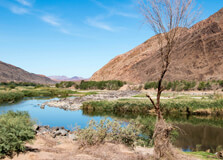
About Richtersveld National Park Richtersveld National Park is a unique and remote wilderness area located in the Northern Cape province of South Africa. It was established in 1991 to protect the diverse desert landscapes and rich biodiversity of the region. The park covers an area of approximately 6,000 square kilometers and is known for its rugged mountains, deep gorges, and arid plains. Location and Geographical Overview The Richtersveld National Park is located in the northwestern corner of South Africa, bordering Namibia to the north and the Orange River to the south. The park is part of the larger Richtersveld Cultural and Botanical Landscape, which was declared a UNESCO World Heritage Site in 2007. The landscape is characterized by extreme temperatures, low rainfall, and unique plant and animal species adapted to the harsh desert environment. Opening and Closing Time The Richtersveld National Park is open year-round for visitors. The park gates are typically open from sunrise to sunset, but specific opening and closing times may vary depending on the season and day of the week. It is recommended to check the official park website or contact park authorities for the most up-to-date information. Entry Fee There is an entry fee for visitors to the Richtersveld National Park, which helps support conservation efforts and maintenance of the park facilities. The entry fee may vary depending on the visitor's age, residency status, and whether they are entering the park on foot, by vehicle, or for camping purposes. It is advisable to check the official park website or inquire with park authorities for current entry fee information. Species-Flora/Fauna Availability The Richtersveld National Park is home to a wide variety of plant and animal species that have adapted to the arid desert environment. Some of the unique flora species found in the park include succulents, quiver trees, and aloe species. The park is also known for its diverse birdlife, reptiles, and small mammals that can be spotted throughout the area. Activities Performed Visitors to the Richtersveld National Park can enjoy a range of outdoor activities, including hiking, birdwatching, photography, and stargazing. The park offers several designated hiking trails that lead through the rugged terrain and provide stunning panoramic views of the surrounding landscape. Guided tours, cultural experiences, and camping facilities are also available for visitors to enjoy. Jeep Safari Charges For visitors looking to explore the park by jeep safari, there may be additional charges for guided tours or vehicle rental services. Jeep safari charges can vary depending on the duration of the tour, the number of participants, and the specific itinerary. It is recommended to book jeep safari experiences in advance and inquire about pricing options with tour operators or park authorities. Age Criterion and Entry Fee The Richtersveld National Park may have specific age criteria for entry fees, with different rates for male, female, and children visitors. Entry fees for senior citizens or pensioners may also be available at a discounted rate. It is advisable to check the park's official website or contact park authorities for age-specific entry fee information and any eligibility requirements. Senior Citizen Facilities Senior citizens visiting the Richtersveld National Park may have access to special facilities or services to enhance their visit. These facilities could include designated parking areas, wheelchair accessibility, rest areas, or discounted rates for entry fees and guided tours. Senior citizens are encouraged to inquire about available facilities and accommodations when planning their visit to the park. Best Time to Visit The best time to visit the Richtersveld National Park is during the cooler months of the year, typically from April to September. The weather is more moderate during this time, making outdoor activities more comfortable and enjoyable. It is important to note that temperatures can be extreme in the summer months, with limited water sources and higher risk of dehydration. Nearby Places to Visit There are several nearby attractions and points of interest for visitors exploring the Richtersveld National Park. The park is located near the town of Eksteenfontein, which offers cultural experiences and opportunities to learn about the local Nama community. Other nearby places to visit include the |Ai-|Ais/Richtersveld Transfrontier Park, the Orange River, and the nearby town of Port Nolloth. Vehicle Parking Facility The Richtersveld National Park provides designated parking areas for visitors entering the park by vehicle. These parking facilities are located near the park entrance and may have limited capacity during peak visitation times. Visitors are advised to follow parking regulations, secure their belongings, and avoid leaving valuables unattended in their vehicles. Rules and Regulations Visitors to the Richtersveld National Park are required to follow certain rules and regulations to ensure the safety of themselves, other visitors, and the park's natural environment. These rules may include guidelines for waste disposal, camping restrictions, wildlife interactions, and off-road driving practices. It is important for visitors to respect the park's rules and regulations to help preserve the unique wilderness of the Richtersveld. How to Reach and Other Related Information The Richtersveld National Park can be reached by road from major cities in South Africa, such as Cape Town or Johannesburg. Visitors can travel by car, bus, or organized tours to reach the park entrance. It is recommended to plan ahead and familiarize yourself with the driving directions, travel times, and road conditions before embarking on your journey to the Richtersveld National Park.
Explore More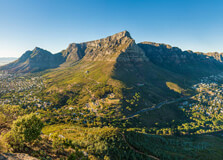
Table Mountain National Park is a breathtaking natural area that surrounds Cape Town and stretches southward along the Cape Peninsula down to the Cape of Good Hope. Covering around 221 km², it was officially proclaimed as a park on 29 May 1998 to conserve the unique fynbos vegetation of the region – part of the Cape Floral Kingdom, one of six plant kingdoms globally and a UNESCO World Heritage Site :contentReference[oaicite:0]{index=0}. Despite its vastness, the park is highly accessible from urban areas, with sections such as Table Mountain, Lion’s Head, Signal Hill, Newlands Forest, Silvermine, Boulders Beach (famous for penguins), and Cape Point easily reached by car, train, bus, and organized tours :contentReference[oaicite:1]{index=1}. How to Reach Table Mountain National Park, Lansdowne The park has multiple entry points spread across the peninsula: Table Mountain: Accessible via Kloof Nek Road by car or by the iconic aerial cableway. Nearest public transport includes MyCiTi buses and taxis to Kloof Street. Lion's Head & Signal Hill: Reachable by car via Signal Hill Drive or by hiring ride-hailing services. Silvermine & Newlands Forest: Reach by car via Tokai Road, with parking at trailheads. Boulders Beach & Cape Point: About a 40-minute drive from central Cape Town via the M4 or Chapman's Peak Drive. Train from Cape Town to Simon's Town also stops nearby :contentReference[oaicite:2]{index=2}. A Cape Town International Airport flight followed by a 25 km drive via the N2 links directly to park regions :contentReference[oaicite:3]{index=3}. Weather at Table Mountain National Park The park’s Mediterranean climate is defined by mild, wet winters (June–August) and hot, dry summers (December–February). Summer temperatures often hover between 25–30 °C with characteristic afternoon south-easterly winds (the “Cape Doctor”) and fog “tablecloth” on the summit :contentReference[oaicite:4]{index=4}. Winters bring rainfall averaging around 650 mm per year, with temperatures ranging between 7–18 °C :contentReference[oaicite:5]{index=5}. Weather can shift rapidly — hikers should pack layers, sun protection, waterproof gear, and ample water :contentReference[oaicite:6]{index=6}. Timings of Table Mountain National Park As an urban-integrated reserve, most sections remain open daily from dawn to dusk. Specific opening hours apply to: Table Mountain Aerial Cableway: Daily, weather permitting (typically mornings to early evenings). Cape Point section: Gates open from 06:00 (October–March), closing after sunset :contentReference[oaicite:7]{index=7}. Silvermine: Daily access, but conservation fees apply at the gate. Boulders Beach: Open daily; conservation fee taken at entrance gate :contentReference[oaicite:8]{index=8}. Why Table Mountain National Park is Famous The park's fame stems from multiple extraordinary attributes: Iconic landmarks: Table Mountain (“New7Wonders of Nature”), Lion’s Head, Signal Hill, Cape of Good Hope, Boulders Beach penguin colony :contentReference[oaicite:9]{index=9}. Fynbos biodiversity: Over 2,200 plant species, many endemic, within the Cape Floral Kingdom UNESCO zone :contentReference[oaicite:10]{index=10}. Wildlife diversity: Home to African penguins, baboons, dassies (rock hyraxes), Cape mountain zebras, antelope, over 250 bird species, dolphins, whales, and more :contentReference[oaicite:11]{index=11}. Urban access: One of few national parks directly adjoining a major city. Recreational variety: Hiking, cable car rides, coastal drives, wildlife viewing, forests, beaches, mountain biking :contentReference[oaicite:12]{index=12}. Entry and Visit Details Most areas are free to enter, but conservation fees apply at Boulders Beach, Silvermine, Cape Point, and Kirstenbosch Gardens. Use SANParks or local site websites to check current prices :contentReference[oaicite:13]{index=13}. Visitors can enter with private vehicles, hire guides, use shuttle or minibus services, or take organized tours. The aerial cableway charges separate fees for rides to the summit :contentReference[oaicite:14]{index=14}. History and Architecture Although natural by origin, the park’s cultural history is rich: Stone Age roots: Prehistoric human activity evidenced by ancient tools found on the mountain :contentReference[oaicite:15]{index=15}. Colonial era: British established monuments, including blockhouses on Table Mountain, Rhodes Memorial on Devil’s Peak, and water reservoirs in the late 1800s :contentReference[oaicite:16]{index=16}. National Park formation: The Cape Peninsula Protected Natural Environment emerged in 1989, later becoming Table Mountain National Park under SANParks in 1998 :contentReference[oaicite:17]{index=17}. World Heritage recognition: Declared part of the Cape Floral Kingdom in 2004; earlier conservation declared nationally in the 1950s–60s :contentReference[oaicite:18]{index=18}. Things to Do at Table Mountain National Park The park offers countless activities: Hiking & trail runs: Popular routes include Platteklip Gorge, Skeleton Gorge, Lion’s Head, Silvermine, and Cape Point trails :contentReference[oaicite:19]{index=19}. Cableway ride: A rotating aerial tram to the summit of Table Mountain :contentReference[oaicite:20]{index=20}. Scenic drives: Along Chapman's Peak and through coastline to Cape Point :contentReference[oaicite:21]{index=21}. Wildlife & bird watching: See penguins at Boulders Beach and abundant fynbos and endemic species :contentReference[oaicite:22]{index=22}. Beach outings: Swimming and relaxing at Boulders, Silvermine reservoir, Groot Olifantsbos :contentReference[oaicite:23]{index=23}. Mountain biking & forest walks: Offered through Silvermine and Tokai areas :contentReference[oaicite:24]{index=24}. Rock climbing & paragliding: Around Table Mountain and Lion’s Head slopes :contentReference[oaicite:25]{index=25}. Whale watching: Seasonal sightings near Cape Point between July–October :contentReference[oaicite:26]{index=26}. Kirstenbosch Garden: Fynbos displays, summer concerts, forest paths :contentReference[oaicite:27]{index=27}. Interesting Facts The park spans 221 km² of land plus 956 km² marine protected area :contentReference[oaicite:28]{index=28}. Home to over 8,000 plant types, including proteas, ericas, restios, and endemic Table Mountain ghost frogs :contentReference[oaicite:29]{index=29}. Boulders Beach hosts a flourishing African penguin colony since 1982 :contentReference[oaicite:30]{index=30}. Lion’s Head is a favorite full-moon hike offering 360° views :contentReference[oaicite:31]{index=31}. Kirstenbosch is among the world’s best botanical reserves, famous for fynbos and outdoor concerts :contentReference[oaicite:32]{index=32}. Former reservoirs on Table Mountain now serve hikers and act as historic reminders :contentReference[oaicite:33]{index=33}. Tips for Visiting Table Mountain National Park Hike in groups of at least four and always inform someone of your route and return time :contentReference[oaicite:34]{index=34}. Stick to marked trails, wear sturdy hiking shoes, layered clothing, and bring sun protection, rain gear, water, and snacks :contentReference[oaicite:35]{index=35}. Avoid bringing valuables; in isolated areas, keep phones and gear out of sight :contentReference[oaicite:36]{index=36}. Begin hikes early to avoid weather changes or darkness :contentReference[oaicite:37]{index=37}. Check weather and cableway status before visiting :contentReference[oaicite:38]{index=38}. Drive slowly in baboon-populated zones and never feed wildlife :contentReference[oaicite:39]{index=39}. For Lion’s Head full-moon hikes, bring a headlamp and avoid alcohol due to steep terrain :contentReference[oaicite:40]{index=40}. Purchase SANParks or Slingsby maps and volunteer brochures for better navigation :contentReference[oaicite:41]{index=41}.
Explore More
Addo Elephant National Park is one of South Africa’s top wildlife destinations and the third-largest national park in the country. Located near the coastal city of Gqeberha (formerly known as Port Elizabeth) in the Eastern Cape, the park is famous for its large population of African elephants and rich biodiversity. It was originally established to protect the last remaining elephants in the region and has since expanded to include a wide variety of habitats and species. The park offers visitors the chance to see the Big Five – elephant, lion, buffalo, rhino, and leopard – along with other animals like zebras, antelopes, and even marine life in its coastal sections. Addo is a fantastic destination for nature lovers, wildlife photographers, and families looking for a memorable safari experience in a malaria-free zone. How to Reach Addo Elephant National Park, Gqeberha By Air: The nearest major airport is Chief Dawid Stuurman International Airport in Gqeberha, which has regular flights from major South African cities like Johannesburg and Cape Town. From the airport, it takes around one hour by car to reach the park’s main gate. By Road: Addo Elephant National Park is easily accessible by car from Gqeberha. The main entrance is about 72 kilometers (45 miles) northeast of the city. The drive is safe and scenic, with clear road signs leading to the park. By Tour: Many tour operators based in Gqeberha offer day trips and multi-day safari packages to Addo, which can include guided game drives, meals, and transfers. Weather in Addo Elephant National Park The park enjoys a mild and pleasant climate throughout the year, making it a great destination at any time. Summer (October to March): Warm temperatures ranging from 20°C to 35°C (68°F to 95°F). Occasional rain showers can be expected, but they don’t last long. Winter (May to August): Cooler temperatures from 5°C to 22°C (41°F to 72°F). Mornings and evenings can be chilly, so warm clothing is recommended. The dry months (May to September) are best for spotting wildlife near waterholes, while the green season (October to April) offers lush scenery and bird watching. Park Timings Addo Elephant National Park is open daily, including public holidays. Opening Time: 7:00 AM Closing Time: 6:00 PM (varies slightly by season) The reception area and gates usually close around 6 PM, so it’s important to plan your game drives accordingly. If you are staying overnight inside the park, you must arrive before the gate closes. Why Gqeberha is Famous Gqeberha, formerly known as Port Elizabeth, is known as the “Friendly City” of South Africa. It serves as a gateway to the Eastern Cape's top wildlife reserves, including Addo Elephant National Park. Gqeberha is also famous for its beautiful beaches, water sports, cultural diversity, and historical sites. The city’s modern airport and coastal charm make it the perfect starting point for an African safari adventure. Entry and Visit Details for Addo Elephant National Park Entry Fees: International Visitors: Around R400 (about $22 USD) per adult South African Citizens: Around R90 per adult (with valid ID) Children: Discounts available for kids under 12 Entry permits can be purchased online through the SANParks website or at the park entrance. Visitors can choose between day visits or overnight stays in various accommodation types such as rest camps, chalets, and safari lodges. The park has restaurants, picnic sites, and shops for visitors’ convenience. History and Architecture of Addo Elephant National Park Addo was established in 1931 after the local elephant population was nearly wiped out due to hunting and human conflict. At that time, only 11 elephants remained in the area. The park started small but has grown over the decades into a massive conservation area that includes mountains, forests, savannas, and even marine environments. Unlike parks with grand buildings, Addo’s architecture blends into the natural environment. Accommodation units are built with eco-friendly materials and are designed to minimize environmental impact while still offering comfort and scenic views. Things to Do in Addo Elephant National Park Self-Drive Safari: Explore the park at your own pace using well-marked roads. Guided Game Drives: Join expert rangers for day or night safaris. Horseback Riding: Enjoy rides through the park’s scenic trails, suitable for all skill levels. Bird Watching: Spot over 400 bird species including eagles, hornbills, and weavers. Picnics and Braais: Rest areas provide places to relax and enjoy a meal in nature. Visit Zuurberg Mountains: Ideal for hiking, scenic drives, and photography. Marine Adventures: In the coastal sections, you might spot whales and sharks in protected waters. Interesting Facts About Addo Elephant National Park It is home to more than 600 elephants – one of the densest elephant populations in the world. Addo is the only park in the world where you can see the Big Seven – the Big Five plus southern right whales and great white sharks. The park is malaria-free, making it safe for families with children. It is one of South Africa’s oldest national parks, with a legacy of over 90 years. Addo is home to unique creatures like the flightless dung beetle, found only in this region. Tips for Visiting Addo Elephant National Park Book your accommodation early during peak seasons (school holidays and summer months). Drive slowly and stay quiet to increase your chances of spotting wildlife. Bring binoculars, a camera, sunscreen, hats, and plenty of drinking water. Always stay in your vehicle unless in designated areas. Follow park rules – don’t feed animals or litter. Check for any park alerts or road closures on the SANParks website before visiting. Try both the northern and southern sections for a more diverse safari experience. Addo Elephant National Park offers a truly South African wildlife adventure with the convenience of being near a major city like Gqeberha. Its variety of animals, easy access, family-friendly environment, and conservation legacy make it a top safari destination for local and international travelers alike.
Explore More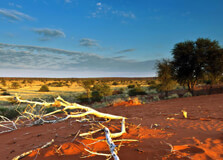
The Kgalagadi Transfrontier Park is one of the most breathtaking wilderness areas in southern Africa. Located approximately 250 kilometers northwest of Upington, in the Northern Cape province of South Africa, this massive reserve spans the borders of South Africa and Botswana, covering over 3.6 million hectares of semi-arid desert. It was one of the first formally declared transfrontier parks in Africa, bringing together the Kalahari Gemsbok National Park in South Africa and the Gemsbok National Park in Botswana. How to Reach Kgalagadi Transfrontier Park, Upington The most common way to reach Kgalagadi Transfrontier Park is via the town of Upington, which is well-connected by road and air. Upington Airport (UPN) receives flights from major South African cities like Johannesburg and Cape Town. From Upington, travelers can drive approximately 250 km north via the R360 road to reach the Twee Rivieren Gate, the main entrance to the park. The drive takes about 2.5 to 3.5 hours and offers beautiful views of the Kalahari landscape. Weather The climate in Kgalagadi is typical of a desert environment—hot and dry during the day with cooler temperatures at night. Summer (October to March) can be extremely hot, with daytime temperatures often exceeding 40°C (104°F). Winter (May to August) brings cooler, more pleasant temperatures ranging between 0°C (32°F) at night and 25°C (77°F) during the day. Rainfall is minimal and occurs mostly between January and April, although it is often unpredictable. Timing The park is open year-round, but the best time to visit is during the cooler months from May to September. The main entrance gates, including Twee Rivieren, are open from 7:30 AM to 7:30 PM in summer and from 7:30 AM to 6:00 PM in winter. Visitors must arrive at their designated campsites before gate closing times. Why Famous for Kgalagadi Transfrontier Park, Upington? Kgalagadi is famous for its incredible wildlife sightings, red sand dunes, and dramatic desert landscapes. The park is a haven for big cats—particularly black-maned Kalahari lions, cheetahs, and leopards. It's also renowned for bird watching, especially raptors like the martial eagle, tawny eagle, and various vultures. The wide, open spaces and absence of large-scale tourism offer a sense of solitude and deep connection with nature, making it a unique safari destination. Entry and Visit Details about Kgalagadi Transfrontier Park, Upington Entry into the park requires a conservation fee, which is payable at the gate. South African citizens and SADC residents pay a lower rate than international visitors. Advance bookings are recommended, especially during school holidays and peak travel seasons. The main entrance, Twee Rivieren, offers a full reception area, fuel station, shop, and accommodation. Visitors can choose from various accommodation types including self-catering chalets, campsites, and wilderness camps. Day visitors are also welcome but must adhere to strict gate times. History and Architecture The Kgalagadi Transfrontier Park was officially established in May 2000 as a collaboration between South Africa and Botswana. It was the first peace park of its kind in Africa, designed to promote conservation across national boundaries. The park protects the Kalahari ecosystem, which is home to numerous migratory animals and traditional pastoral communities. Architectural structures within the park, such as visitor centers and lodges, are built to blend with the desert environment using sustainable materials and designs that minimize environmental impact. Things to Do Game Drives: Self-drive safaris are very popular, with excellent chances to see predators and antelope. Guided drives are also available. Photography: The golden Kalahari light, striking dunes, and diverse wildlife offer superb photographic opportunities. Bird Watching: Home to over 300 bird species, the park is a paradise for bird lovers. Camping: There are several wilderness camps, such as Bitterpan and Grootkolk, offering remote and off-grid experiences. Star Gazing: With little light pollution, the park is ideal for viewing the Milky Way and constellations. 4x4 Trails: There are designated 4x4 routes leading into remote sections of the park and cross-border routes into Botswana. Facts about Kgalagadi Transfrontier Park - The park spans over 38,000 square kilometers across two countries. - It is home to more than 80 species of mammals. - It was the first officially declared transfrontier park in Africa. - The famous black-maned Kalahari lion is unique to this region. - The park's red dunes and fossil river valleys are among the oldest geological formations in Southern Africa. Tips for Visiting Kgalagadi Transfrontier Park, Upington - Always carry plenty of drinking water and sun protection like hats, sunglasses, and sunscreen. - Fuel stations are limited; top up at Twee Rivieren and keep a reserve. - Cell reception is limited—inform someone of your travel plans. - 4x4 vehicles are recommended, especially for remote camps and Botswana sections. - Book accommodation and permits well in advance. - Be respectful of wildlife—never exit your vehicle unless in designated areas. - Carry binoculars and a camera to make the most of your wildlife sightings.
Explore More
Augrabies Falls National Park is a stunning natural wonder located in the Northern Cape province of South Africa, about 120 kilometers west of Upington. The park is centered around the powerful Augrabies Falls, where the Orange River plunges 56 meters into a deep granite gorge. This awe-inspiring sight, along with the park’s unique desert landscape and diverse wildlife, makes Augrabies Falls National Park a must-visit destination for nature lovers and adventure seekers. How to Reach Augrabies Falls National Park, Upington The park is easily accessible from the town of Upington. By road, it takes about 1.5 to 2 hours to reach the park via the N14 and R359 routes. Upington itself is well-connected by flights from major cities like Cape Town and Johannesburg. Once in Upington, visitors can rent a car or take a shuttle service to the park. The roads are well maintained, and the route is scenic, passing through vineyards and semi-desert terrain. Weather Augrabies Falls National Park experiences a semi-arid climate. Summers (October to March) are extremely hot, with temperatures often exceeding 40°C (104°F). Winters (May to August) are milder, with pleasant daytime temperatures ranging between 20°C to 25°C (68°F to 77°F), and colder nights that can drop below 10°C (50°F). Rainfall is low and unpredictable, mostly occurring during the late summer months. The best time to visit is during spring and autumn when temperatures are more moderate. Timing The park is open year-round. The main gate operates from 7:00 AM to 6:00 PM daily. However, visitors staying overnight inside the park must adhere to specific gate times and are not allowed to drive around after dark for safety and conservation reasons. Day visitors are advised to arrive early to enjoy the full experience. Why Famous for Augrabies Falls National Park, Upington? Augrabies Falls National Park is renowned for its majestic waterfall and dramatic granite gorge, known locally as the "Place of Great Noise" due to the thunderous sound of the cascading water. The falls are particularly impressive when the Orange River is in flood. Besides the natural spectacle of the falls, the park is famous for its rugged desert scenery, unique plant life such as quiver trees, and a variety of wildlife including klipspringers, baboons, and even leopards. It also offers excellent stargazing opportunities due to the minimal light pollution. Entry and Visit Details about Augrabies Falls National Park, Upington Entry to the park requires a conservation fee, payable at the gate or online via the SANParks website. South African residents benefit from discounted rates. The park has a well-equipped reception area, information center, and a small shop and restaurant near the main camp. Accommodation is available inside the park and includes family chalets, camping facilities, and safari tents. It's advisable to book accommodation well in advance, especially during holidays. Day visitors can enjoy the falls, hiking trails, and picnic areas. Wheelchair access is available to certain lookout points and facilities. History and Architecture The area around Augrabies has been inhabited for centuries, originally by the San people, who left behind rock art that can still be seen in the region. The park was officially established in 1966 to protect the unique ecosystem around the falls. Architecturally, the park’s buildings are designed to blend with the surrounding rocky landscape using natural stone and muted tones. The main rest camp includes low-profile structures with thatched or stone finishes, designed to offer comfort while remaining unobtrusive in the environment. Things to Do 1. Viewpoints: Several platforms provide stunning views of the falls and gorge, including Ararat and Oranjekom viewpoints. 2. Hiking: Trails like the Dassie Nature Trail and Klipspringer Hiking Trail offer great wildlife sightings and scenic walks. 3. Game Viewing: Spot species like springbok, giraffe, gemsbok, and elusive leopards. 4. Rock Formations: Explore fascinating granite formations such as Moon Rock and Echo Corner. 5. Bird Watching: The park is home to over 180 bird species, including Verreaux’s eagle and African fish eagle. 6. Night Sky Watching: Due to the clear desert skies, stargazing is spectacular. 7. Photography: The rugged landscapes, sunsets, and falls make for amazing photo opportunities. Facts about Augrabies Falls National Park - The waterfall drops approximately 56 meters into a granite gorge that is 240 meters deep and 18 kilometers long. - The name “Augrabies” comes from a Khoi word meaning “Place of Great Noise.” - The park covers around 55,000 hectares of semi-arid terrain. - It is one of the best places in South Africa to see quiver trees (Aloe dichotoma). - The Orange River is the longest river in South Africa, stretching over 2,000 kilometers. - The park has been declared an International Dark Sky Site for astronomy lovers. Tips for Visiting Augrabies Falls National Park, Upington - Visit after rains: The falls are most impressive after seasonal rains when the river is high. - Stay hydrated: The park is hot and dry—always carry water and sun protection. - Book early: Accommodations fill quickly during peak seasons and holidays. - Respect wildlife: Do not feed animals, and stay inside your vehicle in designated areas. - Use walking shoes: Trails can be rocky—proper footwear is essential. - Check weather: Sudden weather changes can affect your plans, especially hikes. - Bring binoculars and camera: You'll want to capture the views and spot distant wildlife. - Keep quiet near the falls: The area is peaceful, and quiet enhances the natural experience.
Explore More